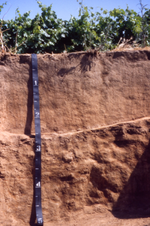

San Joaquin is an officially designated state insignia, the state soil of the U.S. state of California.
The California Central Valley has more than 500,000 acres (2,000 km2) of San Joaquin soils, named for the south end of that valley. This series is the oldest continuously recognized soil series within the state. It is one of California's Benchmark Soils, and a soil profile of it is displayed in the International Soil Reference and Information Centre's World Soil Museum.
The San Joaquin series became the official state soil on August 20, 1997,[1] the result of efforts by students and teachers from Martin Luther King, Jr. Middle School in Madera, natural resource professionals, the Professional Soil Scientists Association of California, legislators, and various state universities.
These soils are used for irrigated crops, such as wheat, rice, figs, almonds, oranges, and grapes, and for pasture and urban development. San Joaquin soils formed in old alluvium on hummocky topography. A cemented hardpan a few feet beneath the surface restricts roots and water percolation.[2] San Joaquin soils are classified in USDA soil taxonomy as fine, mixed, active, thermic abruptic durixeralfs.[3]
- ^ "San Joaquin: The California State Soil". Professional Soil Science Association of California. Archived from the original on 2006-12-29. Retrieved 2006-11-11.
- ^ "San Joaquin - California State Soil" (PDF). USDA - Natural Resources Conservation Service. Retrieved 2006-11-11.[permanent dead link]
- ^ Soil Survey Staff. "Official Soil Series Descriptions". USDA - Natural Resources Conservation Service. Archived from the original on 2006-11-13. Retrieved 2006-11-11.
